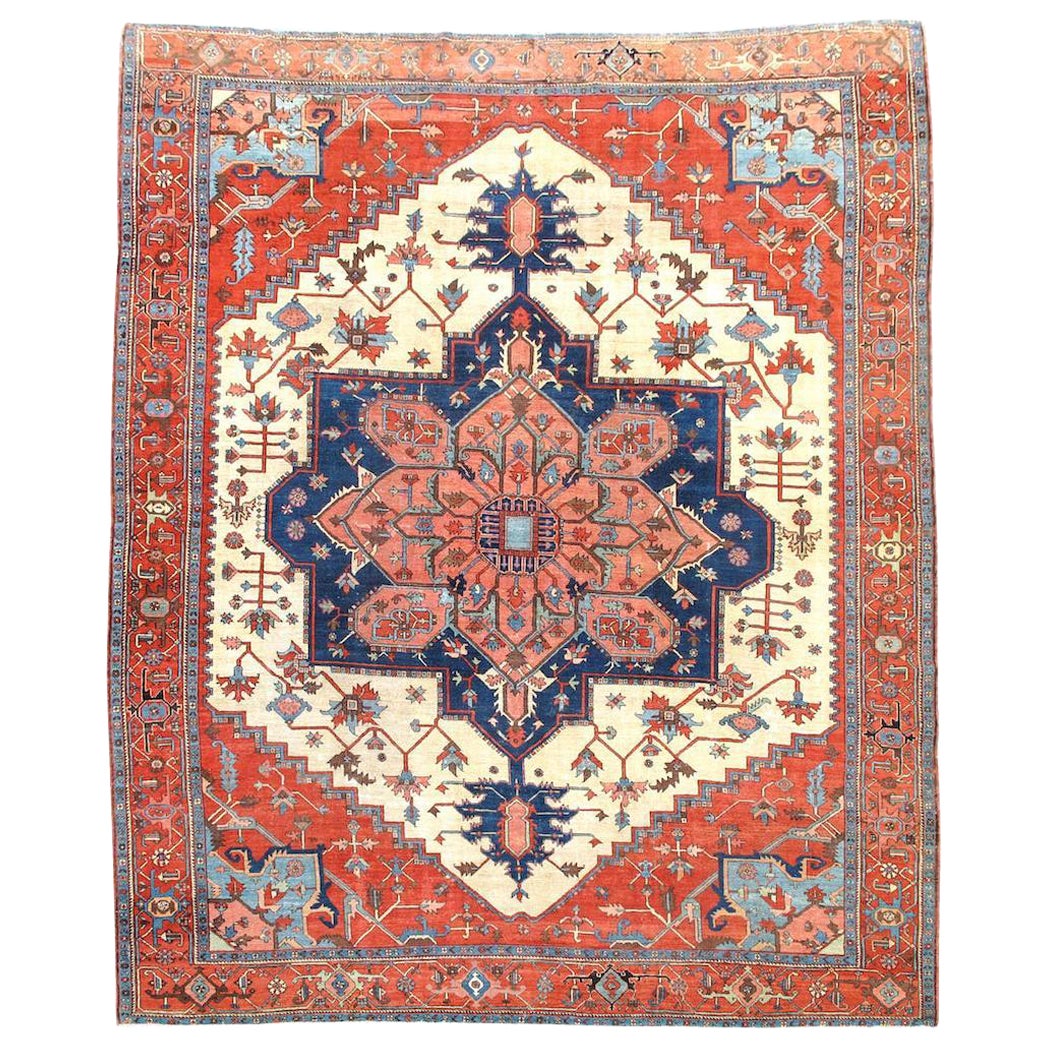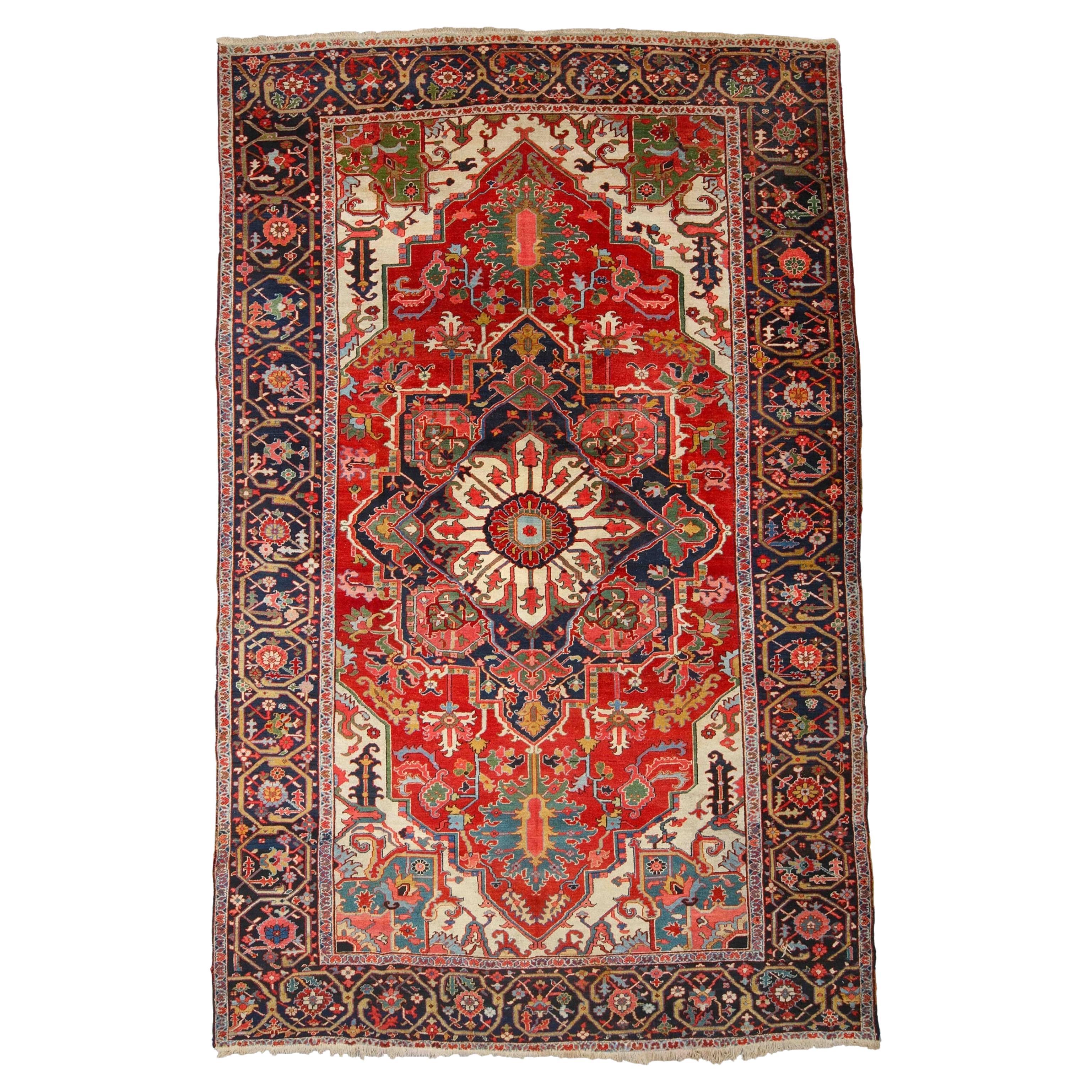Items Similar to 19th Century Antique Persian Serapi Carpet
Want more images or videos?
Request additional images or videos from the seller
19th Century Antique Persian Serapi Carpet
About the Item
Serapi – Northwest Persia
The finest 19th-century Serapis, like this one, perfectly woven and in incomparably good condition, reflect a breathtaking level of originality and perfect aesthetic balance. A fascinating elongated red medallion with an original design stands out in the centre. Its vibrant field features stylized and colourful flowers that seem to float. The main field of the rug in iridescent indigo is highlighted by various exotic leaves and beautifully articulated plants. The rug’s artistic inspiration extends to the ivory-hued leading border. The carpet is clean and ready for use.
Antique 19th-century Serapi rugs are the rarest and most sought-after Persian rugs today. Woven in the mountains of northwest Persia, Serapi rugs are a distinct style from the Heriz region, with finer knots and wider, more spacious designs than other rugs. With an elegant aesthetic, antique Serapis has traditionally been the carpet of choice for American government buildings, including the White House. Today, Serapi rugs are used in traditional and contemporary decorations and in eclectic and post-modern environments.
“Serapi” is not a place or the name of an ethnic group. But it is a term used in the carpet market derived from “Serab-i”, which means “from Serab”. This is because these Persian carpets had to be taken by their weavers to Serab, 45 kilometres away, to be sold.
Antique Serapi rugs were woven by families or in small workshops, with several weavers working for years to finish each carpet. The clothing was done almost exclusively by women. Highly skilled artists continually reinterpreted the design as they wove, creating highly spontaneous and creative art. In general, antique Serapi rugs made in small workshops are finer and more classic and family-woven Serapi rugs feature more symbolic designs. The women of this area were master dyers capable of deeply dyeing silky wool in various colours with “abrash”. The wide range of colours and tones was acquired through many carefully prepared plants and minerals based on no longer known recipes. Colours or shades ranging from watermelon to terracotta were made from madder roots. The many shades of blue, including deep navy, came from the indigo plant. The golden and yellow tones came from chamomile and various other plants. Serapi rug weavers also often used undyed, raw wool, whose ivory and beige tones contrasted with the range of plant colours.
The heavy traffic that Serapi rugs often endure means significant restoration is sometimes necessary for their preservation. If done with skill and care, restoration allows continued use of these majestic antique rugs and increases their investment value. Antique 19th-century rugs with a moderate amount of skillfully executed restoration are pretty rare and, if of excellent quality and solid artistic impact, are highly sought after. Our collection of Serapi rugs reflects a vast variety of this style. We have a carefully selected inventory that attests to the surprising effect these rugs provide to various interiors. The rarity of the best ancient Serapis with pure vegetable dyes, geometric designs and the inspired art of their artists make them excellent investments, occupying an important position in the international art market.
- Dimensions:Width: 98.43 in (250 cm)Length: 149.61 in (380 cm)
- Materials and Techniques:Wool,Hand-Knotted
- Place of Origin:
- Period:
- Date of Manufacture:Circa 1875
- Condition:Repaired.
- Seller Location:Barueri, SP, BR
- Reference Number:1stDibs: LU9788239502012
About the Seller
New to 1stDibs
Joined in the past six months.
No Reviews Yet
Vetted Seller
These experienced sellers undergo a comprehensive evaluation by our team of in-house experts.
1stDibs seller since 2024
- ShippingRetrieving quote...Ships From: Barueri, SP, Brazil
- Return PolicyA return for this item may be initiated within 7 days of delivery.
More From This SellerView All
- 19th Century Antique Persian Serapi CarpetLocated in Barueri, SP, BRSerapi – Northwest Persia This antique Serapi of high artistic calibre features vibrant colours around the large central medallion in blue and salmon on a red background. Every rug ...Category
Antique Late 19th Century Persian Persian Rugs
MaterialsWool
- 19th Century Antique Persian Serapi Palatial Size CarpetLocated in Barueri, SP, BRSerapi – Northwest Persia This ancient Serapi was exquisitely made with the highest artistic and quality materials. It is a piece with perfect aesthetic balance. The central medalli...Category
Antique Late 19th Century Persian Persian Rugs
MaterialsWool
- Antique Persian Kerman CarpetLocated in Barueri, SP, BRKerman – South Persia This luxurious medallion Kerman is made with flowers and vines in the centre of the navy-blue field of the rug. The highlight is the abrash technique used with...Category
Early 20th Century Persian Persian Rugs
MaterialsWool
- Antique Persian Tabriz CarpetLocated in Barueri, SP, BRTabriz – Northwest Persia This is a Tabriz rug inspired by the master of arts Hadji Jallili. Its design emphasizes subtle gradations of colour hue and precise, detailed work. Rather than the predominant medallion most commonly seen in Persian rugs, this magnificent rug displays a concentric series of extremely subtle hexagonal medallions with gently rounded borders. A finely woven geometric pattern called Herati (diamond and leaf pattern) forms the medallions, spreads across the field and continues to the corners of the carpet, adding to the atmosphere of quiet and understated splendour. An elegant rug that chooses those who want to reveal its subtle beauty. The carpet is clean and ready for use. Tabriz, a city located in northwestern Persia, is considered the city of masters of textile art. The ateliers in this influential city established a strong reputation for the quality of their carpets, which is still respected. The city of Tabriz’s fame as a carpet production centre began during the Safavid dynasty (1501 to 1722 AD). However, historical accounts indicate that carpets had been produced there since the Sasanian era (224 to 651 AD). Carpets from the Safavid period represent the pinnacle of Persian textile art, and Tabriz carpets continue this tradition. Shah Abbas (1587–1629), the great patron of the arts, established weaving centres throughout Persia, including a royal workshop in Tabriz. Some of the best Tabriz rugs, woven exclusively for carpet aficionados of the nobility, use techniques that have not yet been surpassed. After the dynasty's fall, carpet-making declined in quality and intensity throughout Persia. However, a renewed interest in 19th-century carpets revived this art, and Tabriz became an important production centre. Antique Tabriz carpets, produced in the late 19th and early 20th centuries, are distinguished by their excellent weaving technique and remarkable adherence to classical traditions and ancient Persian carpet designs. However, unlike other Persian rugs, they cannot be distinguished by any particular design pattern or use of colours. Antique Tabriz rugs come in various classic designs and are produced in every colour imaginable, from bold, bright tones to softer pastel tones. What sets them apart from other Persian rugs is their quality. Tabriz rugs are precisely designed and carefully executed, making them extremely popular with designers. A Tabriz rug adds elegance to any room in a home or office. Tabriz are known for their unsurpassed quality, strong weave and rich detail. For centuries, Tabriz carpets have been made with the highest quality since Tabriz was established as one of the first capitals of the carpet world. The artists of Tabriz boast of being the oldest in terms of production in all of Persia. Tabriz Persian carpets and their beauty not only depend on their rich cultural background but their limitless design is not surpassed by any other region. With an unsurpassed variety of colours, the Tabriz rug can be found in any tone, including bolder or softer pastel tones. Nothing beats antique...Category
Vintage 1930s Persian Persian Rugs
MaterialsWool
- 19th Century Antique Bidjar RugLocated in Barueri, SP, BRBidjar – Northwest Persia This magnificent Bidjar gallery is impressive for its large size and vibrant design, which a master artist made with skilled hands. The navy-blue field is ...Category
Antique Mid-19th Century Persian Persian Rugs
MaterialsWool
- 19th Century Antique Farahan SaroukLocated in Barueri, SP, BRFarahan Sarouk – West Persia The creative use of space, choice of colours, and rare white gold shade create a unique version of this Farahan Sarouk rug. The bright field, highlighte...Category
Antique Late 19th Century Persian Persian Rugs
MaterialsWool
You May Also Like
- Antique Persian Serapi Carpet, Late 19th CenturyLocated in San Francisco, CAAntique Room-Size Persian Serapi Carpet, Late 19th Century This exquisite square-shaped Serapi carpet draws a full Persian medallion within a diamond-shaped ivory field. The scale i...Category
Antique Late 19th Century Persian Persian Rugs
MaterialsWool
- Antique Persian Serapi Carpet, Mid-19th CenturyLocated in Evanston, ILFine 19th-century antique Serapi carpet of Persia. Woven in the rugged mountains of Northwest Persia, Serapi rugs are a distinct Heriz region style, with finer knotting and more large-scale spaciously placed antique carpet designs...Category
Antique Mid-19th Century Persian Heriz Serapi Persian Rugs
MaterialsWool
- Antique Large Persian Serapi Carpet Rug, 19th CenturyLocated in San Francisco, CAAntique Large Persian Serapi Carpet Rug, 19th Century This exceptionally elegant Serapi carpet from Northwest Persia draws a central medallion within a square-shaped field. A centra...Category
Antique 19th Century Persian Persian Rugs
MaterialsWool
- Antique Serapi Carpet - 19th Century Serapi Carpet, Antique RugLocated in Sultanahmet, 3419th Century Serapi Carpet This magnificent 19th-century antique Serapi carpet is a masterpiece that weaves the history, art and culture of its time into its intricate patterns. Eac...Category
Antique 19th Century Asian Persian Rugs
MaterialsWool
- Antique Serapi Carpet - 19th Century Serapi Carpet, Antique Rug, Antique CarpetLocated in Sultanahmet, 3419th Century Serapi Carpet Size: 282x423 cm This impressive 19th-century Serapi Tapestry is a masterpiece reflecting the elegant and sophisticated craftsmanship of a historic period...Category
Antique 19th Century Persian Persian Rugs
MaterialsWool
- 19th Century Antique Persian Serapi Carpet Handmade Oriental RugLocated in Hudson, NYSERAPI RUG: 8'8" X 10'8" Late 19th Century Red field with stylized meandering blossoms and an ivory, pink and blue geometric pendant medallion at the center. Ivory sub-field contains...Category
Antique 1860s Persian Serapi Persian Rugs
MaterialsWool





